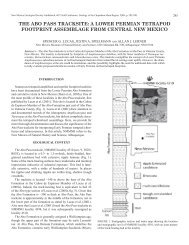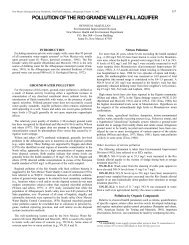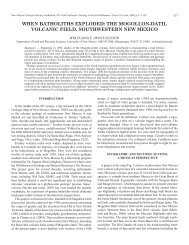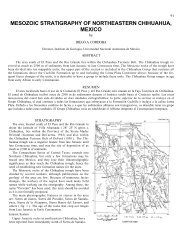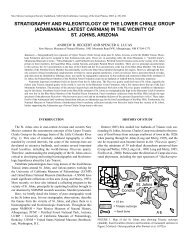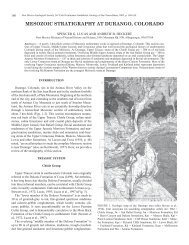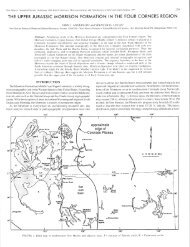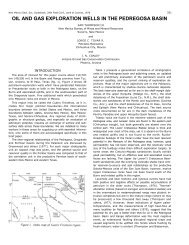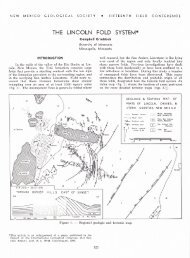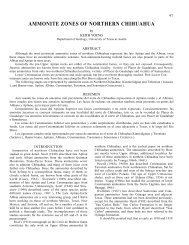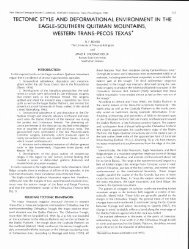The Embudo Fault between Pilar and Arroyo Hondo, New Mexico ...
The Embudo Fault between Pilar and Arroyo Hondo, New Mexico ...
The Embudo Fault between Pilar and Arroyo Hondo, New Mexico ...
You also want an ePaper? Increase the reach of your titles
YUMPU automatically turns print PDFs into web optimized ePapers that Google loves.
EMBUDO FAULT BETWEEN PI LAR AND ARROYO HONDO 79interpreted to be s<strong>and</strong>-dune, playa-type lacustrine <strong>and</strong> alluvialf<strong>and</strong>eposits.<strong>The</strong> s<strong>and</strong>-dune facies consists of buff s<strong>and</strong> in large crossbeddedunits with an easterly paleo-wind direction. <strong>The</strong>se bedsare identical to the typical Ojo Caliente S<strong>and</strong>stone exposed 15mi (24 km) to the west along the Ojo Caliente River. <strong>The</strong>intervening strip is covered by basalts of Black Mesa <strong>and</strong> itsflanking l<strong>and</strong>slide apron so that direct correlation is impossible.<strong>The</strong> playa-type lacustrine facies consists of brownish silt <strong>and</strong>s<strong>and</strong> that is parallel-bedded (vertically accreted windblowns<strong>and</strong>) <strong>and</strong> which contains small carbonate nodules <strong>and</strong> fossilsoil zones.<strong>The</strong> alluvial-fan facies forms ribbed outcrops <strong>and</strong> consists ofgray pebbly gravel that is subangular to subrounded. All clastsare schist <strong>and</strong> quartzite derived from the Precambrian rocksexposed immediately to the south in the Picuris Mountains.<strong>The</strong> gray color is due to the abundance of s<strong>and</strong> <strong>and</strong> smallpebble-sized fragments of black slate <strong>and</strong> phyllite. Placers ofgarnet crystals also are present. <strong>The</strong> average size of the conglomerateclasts is slightly larger in the higher exposed layers.Total exposed section is estimated to be about 1500 ft (460m) thick. <strong>The</strong> base is not exposed <strong>and</strong> the top is an angularunconformity under the Servilleta Formation (Unit D).nating with bluish-gray pebbly s<strong>and</strong>stone. Unit B is dominatedby gravelly s<strong>and</strong>s that have gray or reddish matrices separatedby meter-thick red mudstones. In both units, the gravellylayers are cemented better <strong>and</strong> tend to hold up low ridges. <strong>The</strong>generally uncemented, easily eroded nature of these units isshown by the wide amphitheater (fig. 3) that is eroded intothese units as compared with the usual narrow V-shapedcanyon of <strong>Arroyo</strong> <strong>Hondo</strong>. <strong>The</strong>se units have been recognizedonly in <strong>Arroyo</strong> <strong>Hondo</strong> <strong>and</strong> in the unnamed arroyo immediatelyto the east.Unit C (Ojo Caliente S<strong>and</strong>stone Member of theTesuque Formation)This unit is exposed well on the southward-facing bluffs ofRito Cieneguilla from <strong>Pilar</strong> northeastward. <strong>New</strong> <strong>Mexico</strong> Highway68 parallels this Rito <strong>and</strong> its roadcuts provide many convenientexposures until it tops out on the Taos Plateau. <strong>The</strong>oldest exposed part of Unit C is in the bluffs near <strong>Pilar</strong>, <strong>and</strong>because of consistent west to north dips, progressively youngerbeds are traversed northeastward along Highway 68 until itpasses out of Rito Cieneguilla <strong>and</strong> onto the Taos Plateau.Unit C consists of three distinctive facies that are interbeddedin units 40 to 50 ft (12 to 15 m) thick, <strong>and</strong> which areUnit D (Servilleta Formation)This unit will be described in three segments, in stratigraphicorder from oldest to youngest: the conglomeratesnorth of the <strong>Embudo</strong> fault scarp along the Rio Gr<strong>and</strong>e, theiroverlying basalts, <strong>and</strong> the single basalt <strong>and</strong> associated conglomeratessouth of the <strong>Embudo</strong> fault scarp.<strong>The</strong> canyon of the Rio Gr<strong>and</strong>e north of <strong>Pilar</strong> is carved intothe Servilleta Formation. Near <strong>Pilar</strong>, extensive l<strong>and</strong>slide covermasks the underlying sedimentary rocks except for those bedsimmediately underlying the capping basalts <strong>and</strong> exposures incanyons on the east wall 2.5 mi (4 km) north of <strong>Pilar</strong>. Here,about 500 ft (150 m) of gray pebble-cobble conglomerate thatis subrounded to subangular <strong>and</strong> which coarsens upward areexposed in a steep-walled arroyo. All clasts are of rock typesexposed in the Picuris Mountains to the southeast. Pebble imbrication<strong>and</strong> crossbed transport directions lie in the northwestquadrant. None of the units is of mudflow origin, but insteadis characteristic of braided-stream alluvial-fan types. Presumably,these lie on the Santa Fe Group, but if present aboveriver level, they are covered. <strong>The</strong> widening of the canyon inthis reach might be a result of erosion through the lightlycemented Servilleta sedimentary rocks into the eolian s<strong>and</strong>facies of the Ojo Caliente Member of the Tesuque Formation.<strong>The</strong>se beds dip only a few degrees north <strong>and</strong> west (initial dip?)<strong>and</strong> appear to underlie conformably the capping basalts of theRio Gr<strong>and</strong>e Canyon.<strong>The</strong> basalts exposed along the Rio Gr<strong>and</strong>e Gorge are in distinctpackages of 3-5 flows each separated by sedimentaryinterbeds of varying thickness. <strong>The</strong> lowest exposed basaltpackage terminates a few kilometers north of the confluenceof the Rio Pueblo de Taos <strong>and</strong> the Rio Gr<strong>and</strong>e; the visibleresult is the change in shape of the gorge from a steep V-shaped canyon southward to the wider slump-block-coated U-shaped canyon. Continuing southward, successively higherbasalt packages step farther southward over the northward-



